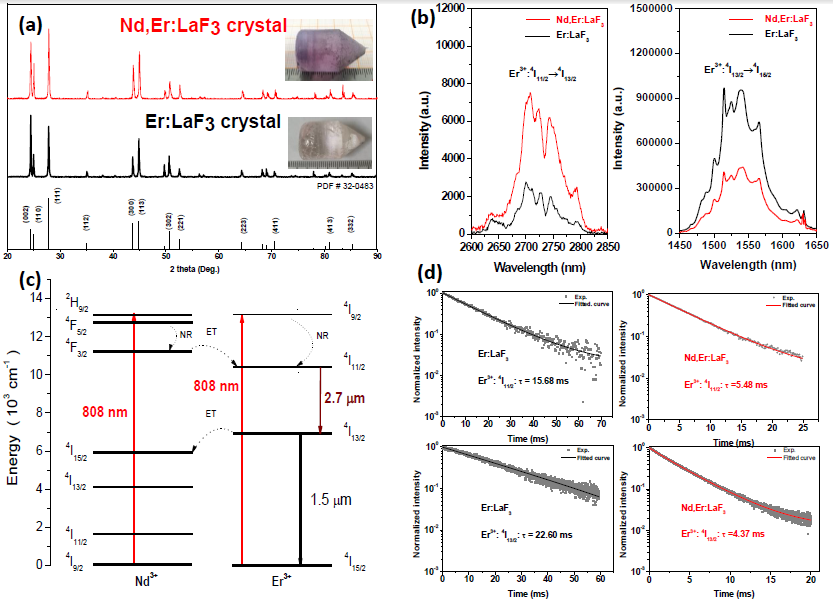In recent years, ~ 3 μm mid-infrared lasers have attracted much attention due to wide applications in biomedical treatments, molecular fingerprint identification and optical parametric oscillation (OPO) pumping source.
Generally, two methods are effective for the realization of mid-infrared laser. One method is a non-linear approach combined with OPO technique, which is structure-complicated and instable. The other method depends on pumping the mid-infrared laser crystal directly, which is more conducive to the development of miniaturization and practicality. The gain-medium is the key to the latter method. The gain media should possess the following advantages: (1) low phonon energy to ensure the high fluorescence efficiency; (2) good infrared transmission characteristics; (3) large emission cross-sections. What's more, self-termination effect should be paid more attention which is the main problem in both Ho3+ (5I6 → 5I7) and Er3+ (4I11 → 4I13) doped host materials.
Recently, a research team from Shanghai Institute of Optics and Fine Mechanics (SIOM), Chinese Academy of Sciences (CAS), has succeeded in developing a new kind of low-phonon-energy laser crystal: Nd,Er:LaF3. The crystal growth, structure, spectra, and self-termination effect were investigated.
For the first time, the 2 at.% Nd, 2 at.% Er:LaF3 crystal was grown successfully by the Bridgman method with the size of Φ20×30 mm3, as far as we know. A 2 at.% Er:LaF3 crystal was also grown for comparison. The Nd,Er:LaF3 crystal remains ![]() space group free from a second phase, the cell parameters of which are a = 7.158
space group free from a second phase, the cell parameters of which are a = 7.158![]() and c= 7.281
and c= 7.281![]() , respectively. The segregation coefficients of Nd3+ and Er3+ are 0.96 and 0.76 respectively, which indicates that it is easy to dope Er3+ ions into LaF3 host.
, respectively. The segregation coefficients of Nd3+ and Er3+ are 0.96 and 0.76 respectively, which indicates that it is easy to dope Er3+ ions into LaF3 host.
The intense 2.7 μm emission of Er3+:4I11/2 →Er3+:4I13/2 in Nd,Er:LaF3 crystal was obtained under the 808 nm LD excitation. With the help of Judd-Ofelt theory and absorption spectra, the fluorescence branching ratio, emission cross-section and measured fluorescence lifetime at 2.7 μm were calculated to be 28.5%, 1.3×10-20 cm2 and 5.48 ms, respectively.
Dual-function of Nd3+ ions were analyzed by comparing the mid-infrared fluorescence spectra (Er3+: 4I11 → 4I13) and lifetimes of the upper and the lower energy levels in singly-doped and doubly-doped crystals. The Nd3+ ions not only sensitize the Er3+ ions but also deactivated the Er3+:4I13/2 energy level effectively by lowering the lifetime of the lower energy level (4I13/2) from 22.60 ms to 4.37 ms with the deactivation efficiency of 80.7% in Nd,Er:LaF3 crystal. It's worth noting that no self-termination effect exists in the Nd,Er:LaF3 crystal.
All the results show that Nd,Er:LaF3 crystal is a promising candidate for 2.7 μm lasers pumped by a commercial 808 nm LD.
The results, entitled “Nd3+ as effective sensitization and deactivation ions in Nd,Er:LaF3 crystal for the 2.7 um lasers”, were published in Journal of Alloys and compounds.
This work was supported by National Natural Science Foundation of China (NSFC) (51472257, 51502321, 51872307); National Key R&D Program of China [2016YFB0701002, 2016YFB0402105, 2016YFB1102302]; Strategic Priority Research Program (B) [No. XDB16]; Major Project of Shanghai Science and Technology Research Foundation [ 16JC1420600]. The authors gratefully acknowledge financial support from China Scholarship Council.

Fig. Characterization of Nd,Er:LaF3 crystal (a: the as-grown crystals and the xrd patterns; b: near and mid infrared emission; c: the schematic of the energy transfer between Nd3+ and Er3+ ions; d:lifetimes of the upper and the lower energy levels) (Image by SIOM)
Article website:
https://doi.org/10.1016/j.jallcom.2020.154268
Contact:
Mr. Wu Xiufeng
General Administrative Office
Shanghai Institute of Optics and Fine Mechanics, CAS
Email: xfwu@siom.ac.cn